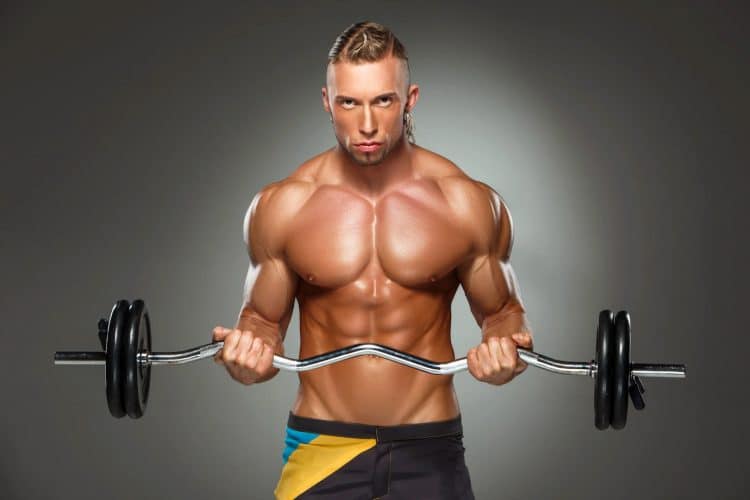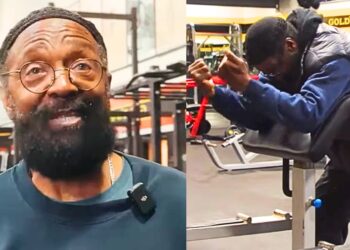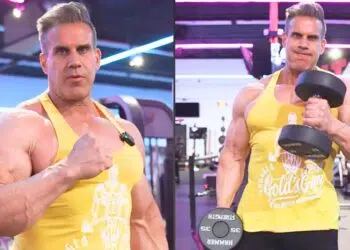Partial reps, which are sometimes called burn reps or simply burns, are nothing new. Bodybuilders have been using partial reps for decades, enjoying the intense pump that this training method produces.
There is even an entire workout program built around partial reps, called Power Factor Training, written by John Little and Peter Sisco.
You can use partial reps on almost any exercise. Still, they work especially well for isolation moves like calf raises, leg extensions, triceps pushdowns, and biceps curls.
Up until now, partial reps have mostly been frowned upon by most training and fitness experts. It’s generally accepted that full-range reps are best, and partials are nothing but bro-science or cheating.
However, there is a 2019 study that suggests that partial reps are not only useful but could actually trigger greater muscle growth than full-range reps. It seems that real science may have finally caught up with bro-science!
In this article, we take a look at the half biceps curl exercise and partial reps to see how this unusual training method could help you build bigger arms.
Level Up Your Fitness: Join our 💪 strong community in Fitness Volt Newsletter. Get daily inspiration, expert-backed workouts, nutrition tips, the latest in strength sports, and the support you need to reach your goals. Subscribe for free!
The Partial Rep Study
While partial reps have been popular in bodybuilding for decades, it wasn’t until 2019 that this type of training was exposed to any real scientific studies. Granted, the study tested partial reps of lying triceps extensions (skull crushers). Still, there is no reason to think that the results of this study are not applicable to the biceps, too.
In the study, scientists in Japan took 44 trained men and divided them into two groups. Half of the men did partial rep triceps training, flexing their elbows from 45 to 90 degrees. The other group did the same exercise but with a full-range movement, i.e., 0 to 120 degrees.
This is what those two different ranges of motion look like:
Each group did three sets of eight reps of skull crushers using their 8-rep maximum three times a week for eight weeks. Loads were increased weekly, as per the principle of progressive overload.
At the end of the eight-week trial, the partial rep group increased triceps size and strength more than the full-range group (1).
How Partial Reps Work
Partial rep exercises, such as half biceps curls, work because of something called occlusion.
Occlusion occurs when a muscle is contracted, and blood cannot flow into or out of whatever body part you are training. This creates hypoxia within the muscle, which is the technical term for oxygen starvation.
Lack of blood flow into a muscle tricks your body into thinking it is working harder than it really is. Lactic acid levels rise, which produces a cascade of anabolic substances, including growth hormone, insulin growth factor, mTOR, and myostatin, all of which are critical for muscle growth.
Then, as blood flow is restored, there is a massive influx of blood back into the target muscle, which produces a terrific pump. The pump is, as every bodybuilder knows, another mechanism of muscle growth (2).
All of this means that partial reps work just like blood flow restriction training, or BFR for short. However, instead of using an external compression cuff to reduce blood flow, partial reps keep your muscles under constant tension to produce the same effect.
Another reason that partial reps are effective for strength and muscle growth is that you should be able to use heavier weights than usual. After all, you’ll be moving through a smaller range of motion which means each rep should be less challenging. Using more weight means more muscle tension, which is yet another trigger for muscle growth.
How to Do Half Biceps Curls
So, partial reps could help you build bigger, stronger muscles, and you can apply this method to most exercises. Still, it generally works best on muscles like the biceps, triceps, quadriceps, and calves. It’s not so useful or practical for the muscles of the torso.
To do partial rep training, all you need to do is focus on the middle part of each rep and stay out of the bottom and top of the usual range of motion.
Level Up Your Fitness: Join our 💪 strong community in Fitness Volt Newsletter. Get daily inspiration, expert-backed workouts, nutrition tips, the latest in strength sports, and the support you need to reach your goals. Subscribe for free!
Experience the power of partial reps for yourself by adding the half biceps curl to your arm workouts.
To do half biceps curls:
- Use an EZ or straight barbell as preferred.
- Hold the bar with an underhand, shoulder-width grip.
- Stand with your arms straight, core braced, and shoulders pulled down and back.
- Bend your arms slightly so your biceps are somewhat shortened. This is your starting position.
- Flex your arms until your forearms are roughly parallel to the floor.
- Extend but do not fully straighten your arms to maintain tension on your biceps.
- Continue for the prescribed number of reps or until reaching failure.
Alternatively, you can do top half curls. For this exercise, start each rep with your arms bent to 90 degrees. Then, curl the weight up to your shoulders and then lower it until your forearms are parallel to the floor. This should have the same effect as regular half biceps curls.
You can also do half biceps curls with:
- Cable curls
- Preacher curls
- Dumbbell curls
- Concentration curls
- Hammer curls
- Plate curls
- Seated barbell curls
- Machine biceps curls, etc.
21s – A Better Variation of Half Biceps Curls?
21s, also known as the Matrix training method, is another variation of partial reps and the half biceps curl.
However, instead of just focusing on the bottom half of the curl, you also do reps in the upper half and then finish off with full-range curls.
21s work for the same reason as partial reps – occlusion. However, they are arguably better than half curls for building functional strength because they involve both the upper and lower range of motion.
How to do 21s:
- Hold a straight or EZ bar with a shoulder-width, underhand grip. Stand with your shoulders down and back, and core braced.
- Moving only your elbows, bend your arms until they’re parallel to the floor. Lower and repeat seven times.
- Next, curl from parallel up to your shoulders. Again, repeat for seven reps.
- Finally, perform seven full-range curls, from full arm extension to full arm flexion.
- Rest a moment and repeat.
You can also do 21s with cable curls, dumbbells curls, machine curls, etc.
Related: How To Build Bigger Arms With Biceps 21s
So, Should You Do Half Reps All the Time?
While half biceps curls and other partial range exercises can trigger muscle growth through occlusion, it’s probably not a good idea to go all partial, all the time.
While one study DOES support half reps for muscle growth, other studies suggest that using a full range of motion is better (3). This is often the way with scientific studies on exercise and training; contradictory and inconclusive results are common.
Also, according to the training law of specificity, your body adapts to the type of workout you do. So, if you always work within a shortened range of movement, that’s what your body will get better at. Your ability to work outside of that range won’t improve much, if at all. If you want to build full-range strength, you need to train using a full range of motion.
Half biceps curls and other partial range exercises are a great addition to your workouts. Still, it’s probably best to perform them alongside full-range movements. That way, you can enjoy all the benefits that partial and full-range exercises have to offer.
Half Biceps Curls – Wrapping Up
Half biceps curls will provide your biceps with a great workout, producing a strong pump and deep burn. While you can do them at any point in your arm workout, they’re probably best used as a finisher at the end of your regular arm workout.
Studies confirm that partial reps are helpful for triggering muscle growth and work because they cause occlusion and hypoxia. But it’s worth remembering that ALL exercises result in hypoxia – that’s the nature of strength training. It’s just more significant when you do things like half curls. You can achieve the same effect using BFR cuffs.
So, use half biceps curls and enjoy their unique training effect, but do them in conjunction with regular biceps exercises for best results. There is no need to do partial reps all the time.
References:
1 – PubMed: Partial Range of Motion Exercise Is Effective for Facilitating Muscle Hypertrophy and Function Through Sustained Intramuscular Hypoxia in Young Trained Men https://pubmed.ncbi.nlm.nih.gov/31034463/
2 – PubMed: The Mechanisms of Muscle Hypertrophy and Their Application to Resistance Training https://pubmed.ncbi.nlm.nih.gov/20847704/
3 – PubMed: Effects of Range of Motion on Muscle Development During Resistance Training Interventions: A Systematic Review https://pubmed.ncbi.nlm.nih.gov/32030125/










Hi Patrick. I’m an old retired army guy from the USA ,and I’m just wondering if I’m doing 90 degree angle isolation movements will the entire length of say,the biceps be activated and equally developed. That’s about it sir. I’m 75 and never stopped working out since I was a kid ,which feels like about as far back as dinosaur days except for my 12 months visiting our friends in Nam in1968, and 🤯 shockingly I’m still here. Amazing! Anyway thanks for the opportunity to ask you a question. Stay well, and never quit….respectively..tom Godwin ([email protected])
Hi Tom and thanks for your question.
Partial ranges of motion don’t really hit different parts of a muscle, e.g., upper or lower biceps for partial curls. That’s not how muscles function. Studies suggest that partial reps to build size throughout the muscle you are training. That said, other studies suggest doing partials in a lengthened position maybe even more effective than mid-range partials.
Personally, I have a hard time with partials because I was brought up on the idea that anything less was full range of motion was cheating! However, that’s my hang-up, and if you like doing partials then they’ll probably make a good addition to your workouts. I would add that partial reps using a shortened ROM could reduce your flexibility, whereas full ROM movements may enhance it.
Ultimately, after training for as long as you have, it’s all about continuing to fight the good fight and training in a way that you enjoy and is consistent. Almost any form of exercise is good exercise, and there is no need to get too hung up on the details. In many cases, even studies revealing any benefits only claim very small advantages over more conventional workout methods.
Good luck with your continued workouts and thanks for reaching out.